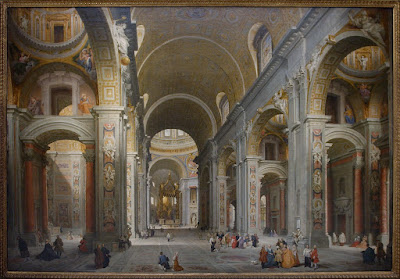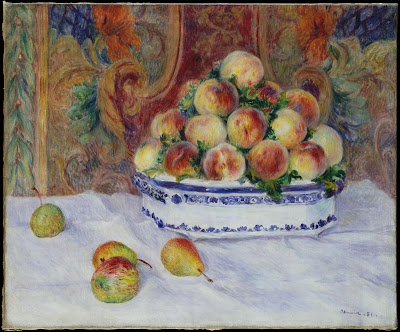 |
| Gian Paolo Panini St Peter's, Rome 1735 oil on canvas Metropolitan Museum of Art, New York |
 |
| Gian Paolo Panini St Peter's, Rome before 1742 oil on canvas National Gallery, London |
 |
| Pompeo Batoni Hercules at the Crossroads 1748 oil on canvas Liechtenstein Museum, Vienna |
 |
| Pompeo Batoni Hercules at the Crossroads 1765 oil on canvas Hermitage, Saint Petersburg |
 |
| François Boucher Portrait of Madame de Pompadour 1758 oil on canvas Victoria & Albert Museum, London |
 |
| François Boucher Portrait of Madame de Pompadour ca. 1758 oil on canvas National Gallery of Scotland, Edinburgh |
"The party was an imposing one as it swept along, dominated by the resplendent figure of To no Chujo himself, who was noticeably taller than the rest and broad-chested to match, fulfilling in dignity of mien and gait all that the popular imagination expects of a great political leader. He was magnificently dressed in long trousers of wine-red silk and a lined cloak, white outside and red within, with a very long and sumptuous train. His costume contrasted in the strangest manner with that of Genji, who had changed into a plain cloak of Chinese silk thrown about him with just that touch of negligence which is proper to a great lord on a small occasion. But the contrast, which would have put anyone else at a disadvantage, only served to show that Genji at his very shabbiest could hold his own against the most grandiose display of trains and trappings."
 |
| Louis-Jean-François Lagrenée Amor and Psyche 1767 oil on panel Nationalmuseum, Stockholm |
 |
| Louis-Jean-François Lagrenée Mercury, Herse, and Aglauros 1767 oil on panel Nationalmuseum, Stockholm |
 |
| Anton Raphael Mengs Self-portrait 1760s oil on panel Prado, Madrid |
 |
| Anton Raphael Mengs Self-portrait 1774 oil on panel Walker Art Gallery, Liverpool |
"By now the evening wind was stirring among the red leaves that lay heaped upon the courtyard floor, weaving them into patterns of brown and red. Here some pretty little boys, children of various noble houses, were imitating in play the dances of their elders. They wore blue and crimson tunics, and shirts of yellow with dark-red facings. Apart from their little Court hats they had no formal insignia, and it was a pretty sight to see them capering about amid the maple leaves, through which the setting sun now slanted its last rays. The professional musicians were not called upon to give any very exacting performance, and at an early hour the private playing began, led by the Emperor, who sent to the Palace Library for a selection of zitherns. Prompted by the beauty of the season and hour, one after another of the great personages there present called for his instrument and gave vent upon it to the feelings of the moment. Suzaku was deeply moved at hearing the familiar tones of Uda no Hoshi. Turning to the Emperor he recited the verse: 'Though, watcher of the woods, through many rainy autumns I have passed, such tints as these it never was my lot in any devious valley to behold.' He said this in his usual tone of gentle complaint. The Emperor answered: 'You speak as though mere leaves were on the ground; here rather has autumn woven a brocade that, could it be an heirloom, after-ages would covet to possess.'"
 |
| Joseph Wright of Derby Annual Girandola at Castel Sant’ Angelo, Rome ca. 1775-76 oil on canvas Walker Art Gallery, Liverpool |
 |
| Joseph Wright of Derby Fireworks display at Castel Sant' Angelo - La Girandola 1779 oil on canvas Hermitage, Saint Petersburg |
 |
| Thomas Lawrence Portrait of Miss Harriet Clements ca. 1805 oil on canvas Indianapolis Museum of Art |
 |
| Thomas Lawrence Portrait of Caroline Matilda Sotheron ca. 1808 oil on canvas Art Gallery of South Australia, Adelaide |
"As usual, her gentlewomen were not under very good control, and a patch of bright sleeve or skirt constantly obtruded, as some spectator, in her excitement, tugged back a corner of the curtains through which the ladies of the house were watching the game. And behind the curtains there showed all the time gay strips of colour, flashing like prayer-strips at the roadside on a sunny spring day. The Princess's screens-of-state were carelessly arranged; she was not in the least protected on the side from which she was most likely to be seen. Still less was she adequately prepared for such an accident as now occurred; for suddenly a large cat leapt between the curtains in pursuit of a very small and pretty Chinese kitten. Immediately there was a shuffling and scuffling behind this screen, figures could be seen darting to and fro, and there was a great rustling of skirts and sound of objects being moved. The big cat, it soon appeared, was a stranger in the house, and lest it should escape it had been provided with a leash, which was unfortunately a very long one, and had now got entangled in every object in the room. During its wild plunges (for it now made violent efforts to get free) the creature hopelessly disarrayed the already somewhat disorderly curtains, and so busy were those within disentangling themselves from the leash that no one closed the gap. In the foreground was plainly visible a group of ladies in a state of wild excitement and commotion. A short way behind them was a little figure standing up, dressed in a long robe without mantle. It was a red plum-blossom gown, with many facings, that showed one overlapping another, in different tinges of the same colour, like the binding of a book. Her hair, shaking like a skein of loose thread, was prettily trimmed and thinned out at the ends, but still reached to within a few inches from the ground. The contrast between the numerous overlapping thicknesses of her dress and her own extreme slimness and smallness was very alluring, her movements were graceful, and her hair, above all when seen with her head in profile, was unusually fine. Kashiwagi, as he peered through the growing darkness, wished that the accident had happened somewhat earlier in the evening. At this moment the cat gave a frenzied scream, and Nyosan turned her head, revealing as she did so a singularly unconcerned and confident young face. Yugiri feared that he would be held responsible for this indiscretion, and was on the point of going up to the window and protesting; but he felt that this would draw further attention to the incident, and contented himself with clearing his throat in a loud and significant manner. Nyosan immediately vanished amid the shadows, rather too rapidly to suit the taste of Yugiri, who had a considerable curiosity about the girl, and would, had he dared, gladly have availed himself of this opportunity to look at her for a little while longer. But by now the cat had been extricated; the screens and curtains were restored to proper order, and there was no chance that the intriguing vision of a moment ago would be repeated."
 |
| Samuel Palmer The Timber Wain 1833-34 watercolor, gouache Yale Center for British Art |
 |
| Samuel Palmer The Weald of Kent 1833-34 watercolor Yale Center for British Art |
 |
| Édouard Manet Execution of Maximilian 1867 oil on canvas Kunsthalle, Mannheim |
 |
| Édouard Manet Execution of Maximilian 1867 oil on canvas Museum of Fine Arts, Boston |
 |
| Gustave Moreau The Apparition (Salome) ca. 1874-76 watercolor Musée d'Orsay, Paris |
 |
| Gustave Moreau The Apparition (Salome) ca. 1876-77 oil on canvas Harvard Art Museums |
"She was in an unlined dress of dark grey-brown that was pleasantly set off by her wide sedge-coloured trousers. Some people are born to wear mourning – so far from being disfigured by it they look more radiant than ever, and it seemed that Kozeri was one of these."
– quoted passages from The Tale of Genji by Lady Murasaki, completed around the year 1021 (though an early version was read aloud to the Emperor in 1008), translated into English for the first time by Arthur Waley (1925)
 |
| Auguste Renoir Still-life with Peaches 1881 oil on canvas Metropolitan Museum of Art, New York |
 |
| Auguste Renoir Still-life with Peaches and Grapes 1881 oil on canvas Metropolitan Museum of Art, New York |